Punjab State Board PSEB 8th Class Science Book Solutions Chapter 2 Microorganisms: Friend and Foe Textbook Exercise Questions and Answers.
PSEB Solutions for Class 8 Science Chapter 2 Microorganisms: Friend and Foe
PSEB 8th Class Science Guide Microorganisms: Friend and Foe Textbook Questions and Answers
Exercises
Question 1.
Fill in the blanks:
(а) Micro-organisms can be seen with the help of a ……………. .
Answer:
microscope
(b) Blue green algae fix ……………….. directly from air to enhance fertility of soil.
Answer:
nitrogen
(c) Alcohol is produced with the help of …………………
Answer:
yeast
(d) Cholera is caused by ……………. .
Answer:
bacteria
![]()
Question 2.
Tick the correct answer:
(a) Yeast is used in the production of:
(i) sugar
(ii) alcohol
(iii) hydrochloric acid
(iv) oxygen.
Answer:
(ii) alcohol
(b) The following is an antibiotic :
(i) Sodium bicarbonate
(ii) Streptomycin
(iii) Alcohol
(iv) Yeast.
Answer:
(ii) streptomycin.
(c) Carrier of malaria-causing protozoan is:
(i) female anopheles mosquito
(ii) cockroach
(iii) housefly
(iv) butterfly.
Answer:
(i) female anopheles mosquito.
(d) The most common carrier of communicable diseases is :
(i) ant
(ii) housefly
(iii) dragonfly
(iv) spider.
Answer:
(ii) housefly.
(e) The bread of idli dough rises because of:
(i) heat
(ii) grinding
(iii) growth of yeast cells
(iv) kneading.
Answer:
(iii) growth of yeast cell.
(f) The process of conversion of sugar into alcohol is called:
(i) nitrogen fixation
(ii) moulding
(iii) fermentation
(iv) infection.
Answer:
(iii) fermentation.
Question 3.
Match the organisms in Column ‘A’ with their action in Column ‘B’
| Column A | Column B |
| (i) Bacteria | (a) Fixing nitrogen |
| (ii) Rhizobium | (b) Setting of curd |
| (iii) Lactobacillus | (c) Baking of bread |
| (iv) Yeast | (d) Causing malaria |
| (v) A protozoan | (e) Causing cholera |
| (vi) A virus | (f) Causing AIDS |
| (g) Producing antibodies |
Answer:
| Column A | Column B |
| (i) Bacteria | (а) Causing cholera |
| (ii) Rhizobium | (b) Fixing nitrogen |
| (iii) Lactobacillus | (c) Setting of curd |
| (iv) Yeast | (d) Baking of bread |
| (v) A protozoan | (e) Causing malaria |
| (vi) A virus | (f) Causing AIDS |
![]()
Question 4.
Can micro-organisms be seen with the naked eye ? If not, how can they be seen ?
Answer:
No, micro-organisms cannot be seen with naked eye because they are too small. So, we can only see them under microscope.
Question 5.
What are the major groups of micro-organisms ?
Answer:
The various groups of micro-organisms are:
- Bacteria
- fungi
- protozoa
- algae
- virus.
Question 6.
Name the micro-organisms which can fix atmospheric nitrogen in the soil.
Answer:
- Rhizobium bacteria
- Blue green algae.
Question 7.
Write 10 lines on the usefulness of microorganisms in our lives.
Answer:
Micro-organisms are bacteria, fungi, algae and protozoans. The beneficial aspects of Micro-organisms are as given ahead:
Beneficial aspects of Bacteria:
- Formation of milk products like curd and cheese.
- Tenderization of meat by breaking down tough muscle fibre.
- Formation of vinegar and wines.
- Decomposition of organic matter.
- Tanning of leather.
- Conversion of atmospheric nitrogen to usable nitrogenous compounds.
Beneficial aspects of Fungi:
- Production of bakery products like bread and cakes.
- Other products like idli, dosa, processed cheese, etc.
- Beverages like wines, beers, etc.
- Mushrooms are edible fungi.
- Medicines such as penicillin are made from fungi.
Beneficial aspects of Algae:
They help in the production of organic matter through photosynthesis which provides food to aquatic animals.
- Algae cell extracts like agar and alginic acid are used for preparing medicines, food and cosmetics, etc. Kelp that is a brown algae is a rich source of iodine and potassium.
- The cell walls of diatom (an alga) are a natural source of fine silica.
- Many sea weeds are used as food in China and Japan.
Beneficial aspects of Protozoans:
- They form an important link in the food chain.
- They feed on fungi and bacteria. Mix it with potato glucose solution prepared earlier. Store the mixture so obtained in the suitable container. The PDA medium is ready and can now be used to culture microorganisms in petri dishes or test tubes.
Question 8.
Write a short paragraph on the harms caused by microorganisms.
Answer:
Harmful effects of Microorganisms:
1. These microorganisms cause a large variety of diseases in plants, animals and human beings.
2. They spoil food items as well as other articles like clothes, leather etc.
3. Micro-organisms spoil food by:
- breaking down its molecules and make new products called (amines) which are generally smelly. This changes its chemical composition as well as its texture and physical appearance.
- some microbes secrete poisonous substances called toxins which if consumed lead to food poisoning.
- micro-organisms grow in the food and sometimes form a whole colony consisting of such large numbers that this food, if consumed can cause illness. It is called food poisoning.
Question 9.
What are antibiotics ? What precautions must be taken while taking antibiotics ?
Answer:
Antibiotics. These are those chemical secretions which are secreted by certain microorganisms and inhibits the growth of other microorganisms without harming the host.
Alexander Fleming, an English scientist in 1929, discovered Penicillin.
Precautions to be taken while taking antibiotics
Given ahead precautions should be taken while taking antibiotics:
- Antibiotics should be taken only on the advice of a qualified doctor,
- You must finish the course prescribed by the doctor,
- Antibiotics, however, are not effective against cold and flu as they are caused by viruses.
PSEB Solutions for Class 8 Science Microorganisms: Friend and Foe Important Questions and Answers
Multiple Choice Questions
Question 1.
The following slide shows which micro-organism ?
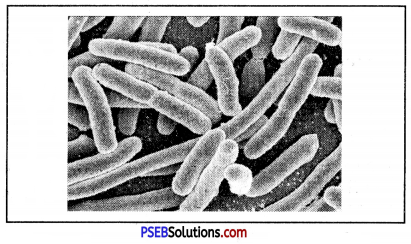
(a) Spirogyra
(b) Amoeba
(c) Bacteria
(d) Fungi on bread.
Answer:
(c) Bacteria.
![]()
Question 2.
Is of which micro-organism is shown in the diagram ?
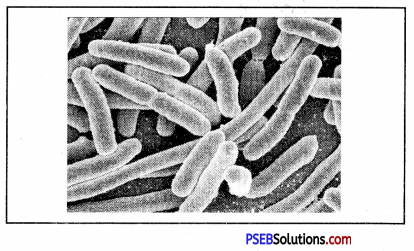
(a) Spirogyra
(b) Amoeba
(c) Bacteria
(d) Fungi on bread
Answer:
(c) Bacteria
Question 3.
The slide which is being shown below with the help of microscope is of which micro-organism ?
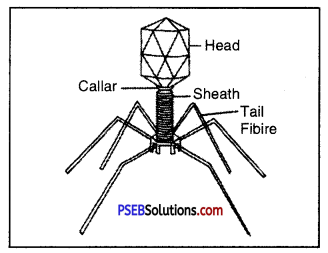
(a) Amoeba
(b) Bacteria
(e) Paramecium
(d) Virus
Answer:
(d) Virus.
Question 4.
Which of the following micro-organisms can be seen only with the help of microscope ?
(a) Virus
(b) Bacteria
(c) Yeast
(d) All of the above.
Answer:
(d) All of the above.
Question 5.
Today the teacher in the class showed a slide to his students with the help of microscope. To which micro-organism does this slide belong ?
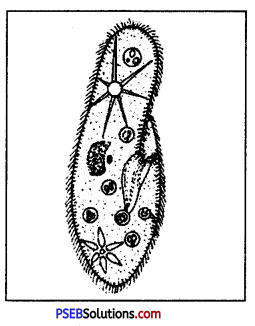
(a) Amoeba
(b) Bacteria
(e) Paramecium
(d) Penciliam
Answer:
(c) Paramecium.
Question 6.
For what purpose yeast is used ?
(a) Sugar
(b) Wine
(c) Hydrocloride Acid
(d) Oxygen
Answer:
(b) Wine
Question 7.
Which of the following is antibiotics ?
(a) Sodium Bicarbonate
(b) Streptomycin
(c) Alcohol
(d) Yeast
Answer:
(b) Streptomycin.
Question 8.
The carrier of malaria-causing protozoan is:
(a) Female anopheles mosquito
(b) Cockroach
(c) Housefly
(d) Butterfly
Answer:
(a) Female anopheles mosquito.
![]()
Question 9.
The most common carrier of communicable diseases is:
(a) Ant
(6) Housefly
(c) Dragonfly
(d) Spider.
Answer:
(b) Housefly
Question 10.
The bread or idli dough rises because of:
(a) Heat
(b) Grinding
(c) The growth of yeast cells
(d) Kneeding
Answer:
(c) The growth of yeast cells.
Question 11.
The process of conversion of sugar into alcohol is called:
(a) Nitrogen fixation
(b) Moulding
(c) Fermentation
(d) Infection.
Answer:
(c) Fermentation.
Question 12.
Which instrument is used to see micro-organisms ?
(a) Magnifying glass
(b) Microscope
(c) Telescope
(d) All the above.
Answer:
(b) Microscope.
Question 13.
Which of the following micro-organisms is responsible for causing cholera ?.
(a) Virus
(b) Protozoa
(c) Bacteria
(d) None of these.
Answer:
(c) Bacteria.
Very Short Answer Type Questions
Question 1.
Fill in the blanks:
1. Microorganisms can be seen with the aid of ……………….. .
Answer:
microscope
2. Bacteria normally multiply by ……………….. .
Answer:
binary fission
![]()
3. Disease producing microbes are called ……………….. .
Answer:
pathogens
4. The poisonous substances produced by some pathogenic bacteria are known as ……………… .
Answer:
toxins
5. Algae can make their own food because they can ………………… .
Answer:
photo- synthesise
6. The chief source of food for fishes is ……………….. .
Answer:
algae
7. The product of algae used for raising bacterial culture is called ……………….. .
Answer:
agar
8. Algae are plant-like but ……………….. are animal-like.
Answer:
protozoans
9. Mushroom is a type of ………………. .
Answer:
fungus
10. Microorganisms which form the borderline between the living and nonliving world are called …………..
Answer:
viruses
![]()
Question 2.
Define microscope.
Answer:
Microscope. It is an optical instrument which enables us to see the very tiny organisms called microorganisms.
Question 3.
Which micro-organism lies on the borderline dividing the living world from the non-living ?
Answer:
Virus lies on the borderline dividing the living and non-living.
Question 4.
Name four antibiotics.
Answer:
Penicillin, Streptomycin, Tetracycline and Gramicidin.
Question 5.
What are micro-organisms ?
Answer:
Micro-organisms. These are small organisms which are too small to be seen with naked eyes.
Question 6.
Name the major groups of micro organisms.
Answer:
The major groups of microorganisms are:
Bacteria, Fungi, Protozoa, Algae and Viruses.
Question 7.
Write the average size of bacterium.
Answer:
1.25 mm (1μm = \(\frac{1}{1000}\) mm) in diameter.
Question 8.
Which is the smallest bacteria ?
Answer:
The smallest is rod-shaped bacteria measuring 0.15 mm.
Question 9.
Name the largest bacteria.
Answer:
Spiral shaped bacteria measuring upto 15 mm in length and 1.5 μm in diameter.
![]()
Question 10.
Name two examples of Bacillus.
Answer:
Lactobacillus, Pseudomonas.
Question 11.
Write examples of blue-green algae.
Answer:
Nostoc, Anabaena, Oscillatoria.
Question 12.
How much nitrogen is fixed by blue-green algae in a paddy field in a year ?
Answer:
About 625 kg of nitrogen in one square km area.
Question 13.
Which micro-organism is used in the preparation of bread and alcohol ?
Answer:
Yeast.
Question 14.
Name two nitrogen fixing algae.
Answer:
Nostoc and Anabaena.
Question 15.
What are the two major groups of fungi ?
Answer:
Yeast and moulds.
Question 16.
Under which group of micro-organisms Amoeba fall ?
Answer:
Protozoa.
Question 17.
Name two antibiotics.
Answer:
- Streptomycin
- Erythromycin.
![]()
Question 18.
Who discovered vaccination ?
Answer:
Louis Pasteur.
Question 19.
Name unicellular micro-organism.
Answer:
Bacteria, Protozoa.
Question 20.
Name multicellular micro-organisms.
Answer:
Algae, Fungi.
Question 21.
Name a micro-organism which can live independently.
Answer:
Amoeba.
Question 22.
Name micro-organisms which live in groups.
Answer:
Fungi and Bacteria.
Question 23.
For which purpose antibiotics are used ?
Answer:
Antibiotics are used for curing diseases.
Question 24.
Which micro-organisms are used to prepare antiboitics ?
Answer:
Bacteria and Fungi.
Question 25.
When and who first invented first antiboitic ?
Answer:
Alexander Fleming in 1929, invented first antibiotic.
![]()
Short Answer Type Questions
Question 1.
Are all micro-organisms of similar sizes ?
Answer:
No, all micro-organisms are not of similar size. The size of bacteria ranges from 0.2 to 100 microns. The size of yeast ranges from 5 to 10 micron and that of moulds from 2 to 10 micron. The size of algae ranges from 1 micron to several metres in length. The size of protozoa ranges from 2 to 200 microns. The size of viruses ranges from 0.015 to 0.2 micron.
Question 2.
Give examples of a slow and fast growing bacteria.
Answer:
Examples of slow growing bacteria:
- Mycobacterium tuberculi
- Mycobacterium leprae
Examples of fast growing bacteria:
- Pseudomonas
- E. coli.
Question 3.
What are the two groups of organisms of fungi ?
Answer:
Fungi consists of two main groups:
Yeasts and Moulds.
- Yeasts. They are usually unicellular.
- Moulds. They are usually multicellular and have a filament-like appearance.
Question 4.
How do microbes survive adverse conditions ?
Answer:
Micro-organisms are very hardy. They can survive under extreme conditions of temperature and dryness by forming a hard outer coating called a cyst. Within this protective shell, they remain inactive as such, until more favourable conditions return. They, then emerge from their shell, multiply and go through their life cycles.
Question 5.
In what ways, are viruses different from other microbes ? Name two plant viruses and two animal viruses.
Answer:
Viruses are different from other microbes due to the following facts:
1. They are the smallest microbes.
2. They cannot be totally called living beings because they do not grow on their own.
3. They are mostly harmful and cause a number of diseases.
Plant viruses.
- Tobacco mosaic virus (TMV)
- Bacteriophage.
Animal viruses.
- Foot and mouth disease virus (FMDV)
- Measle virus.
Question 6.
Why are viruses placed on the border line between living and nonliving things ?
Answer:
Viruses resemble living objects due to following reasons:
- They contain nucleic acids.
- They grow and multiply like living beings.
Viruses resemble non-living things due to the following reasons:
- They do not contain cytoplasm and definite nucleus.
- They can be crystallized like salts or sugar.
Question 7.
Differentiate between yeasts and moulds.
Answer:
Differences between Yeasts and Moulds
| Yeasts | Moulds |
| 1. They are unicellular. | 1. They are multi-cellular. |
| 2. They range in size from 5-10 microns. | 2. They range in size from 2-10 microns. |
| 3. Yeasts are both aerobic as well as anaerobic. | 3. Moulds are aerobic. |
![]()
Question 8.
Write some examples of commercial products obtained from fungi.
Answer:
- Some fungi are directly used in the preparation of dishes.
- Some antibiotics are obtained from fungus.
- Some fungi are used in the preparation of bread and alcohol.
- Wines, beers are prepared with the help of certain fungi.
Question 9.
What are Bacteriophages ?
Answer:
Bacteriophage. Viruses are heterotrophic. Virus which depend on bacteria are called bacterial viruses or bacteriophages.
It is shaped like a rod. They destroy bacteria which are responsible for spoilage of organic matter.
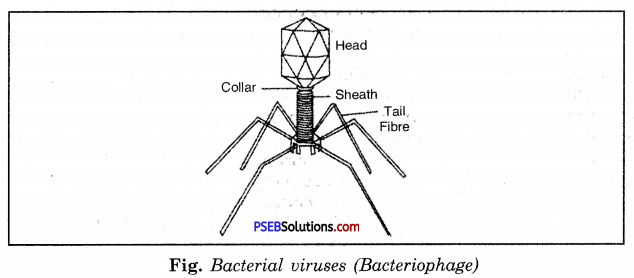
Question 10.
Describe the various products involving action of fungi.
Answer:
The various products involved are as follows:
- Bakery products. Bread and cakes from wheat flour.
- Food products. Wines, beers from fruit juices or barley ; idli and dosa from a mixture of powdered rice and dal.
- Processed cheese.
- Some fungi such as mushrooms are directly used as food products.
- Some very important medicines, such as penicillin are made from fungi.
- Moulds spoil food, damage potato and crop plants, corn and wheat. They also cause rotting of clothes, shoes and wooden materials.
- Some fungi cause diseases like athlete’s foot and ringworm.
Question 11.
How is bread formed ?
Answer:
When yeast together with some sugar and warm water is mixed with flour (atta or maida), the dough begins to rise. The presence of sugar and the warmth stimulates rapid growth of the yeast cells. During their reproduction, yeast cells produce carbon dioxide. Bubbles of CO2 fill the dough and make it rise. When baked into a loaf, the bread becomes light and spongy.
Question 12.
How is the mixture of ground rice and dal made sour ?
Answer:
The mixture of ground rice and dal is allowed to stand for a few hours. It becomes sour. It is the growth of yeast cells that causes the mixture to rise and become sour.
Question 13.
Suggest some methods to prevent the growth of moulds.
Answer:
- Keep the things at low temperatures.
- Keep the things in clean closed containers.
- Keep the things in dry condition in dry storage.
- Keep the food in the form of syrups, pickles, in the form of preserved food.
- Keep the articles away from the reach of microorganisms present in the air.
Question 14.
Write the importance of fungi in medicines.
Answer:
Antibiotics are obtained from fungi, and Penicillin is obtained from the fungus, Griscofulvin is extracted from the fungus Griscofulvum.
![]()
Question 15.
What are the major differences between algae and fungi ?
Answer:
| Algae | Fungi |
| 1. Green in colour. | 1. Colourless or non-green. |
| 2. Outer cell wall is formed by cellulose. | 2. Outer cell is formed of fungus cellulose. |
| 3. Autotrophic. | 4. Saprophytic or Parasitic. |
| 4. Aquatic in habitat. | 3. Heterotrophic. |
| 5. Grow on wet surfaces. | 5. Grow on moist organic surface. |
Question 16.
What are vaccines ?
Answer:
Vaccines.
A vaccine consists of antigens of mild strains of pathogens of a specific disease. When injected into the blood stream, it stimulates while blood cells to produce antibodies.
Question 17.
Describe the role of blue green algae in the fertility of soil.
Answer:
Blue green algae play an important role in the fertility of soil due to the following reasons:
- They make the nitrogen available to the soil.
- They increase the humus content of the soil.
- They support the crop growth.
- They improve the water holding capacity of the soil.
Question 18.
Describe some of the important landmarks in the study of microorganisms.
Answer:
Important landmarks in the study of microorganisms are as follows:
| Name of the scientist | Year | Contribution |
| Robert Hooke | 1665 | Observed cork cells, spermatozoa and bacteria using a simple microscope and named them as tiny animalcules. |
| Louis Pasteur | 1857
1859 |
Fermentation is a biochemical process.
Microbes produce only from pre-existing microbes of same species. |
| Robert Koch | 1872 | Tubercle bacillus is the main cause of tuberculosis germ theory of disease. |
| Shikabasaburo
Alexander Fleming |
1889
1929 |
Tetanus disease is due to Tetanus bacillus.
Antibiotic penicillin from Penicillium notatum (a fungus). |
Question 19.
What is food poisoning ?
Answer:
Food Poisoning. Sometimes the microorganisms grow on our food items and spoil it. When we eat this food, it causes food poisoning. It causes serious illness and even death.
Question 20.
Explain the following terms in brief:
(a) Immunity
(b) Antibodies
(c) Vaccination.
Answer:
(a) Immunity.
Immunity is the ability of a person (or organism) to resist the development of a disease even when infective dose of the pathogen has been introduced. The science of development of resistance or defence to the causative agents of the diseases is termed as immunology. Foundations of immunology were laid by Edward Jenner (1796) who successfully developed first vaccine against small pox.
(b) Antibodies.
It is a substance occurring naturally in the blood or produced in response to the presence of antigen which is able to overcome the toxic effect of an antigen.
(c) Vaccination.
It is a process of injecting a substance (Vaccine) into a healthy person in order to develop immunity against a specific disease.
![]()
Question 21.
Write three ways of entering microorgnisms into the body.
Answer:
Entry of microorganisms into the body
- Through the air we inhale.
- Through the water we drink, and the food we eat.
- Through skin.
Question 22.
What is vaccine ? Describe the importance of vaccination.
Answer:
Vaccine. A vaccine consists of a small amount of dead or weakened germs of a particular disease that are injected into the body. Injecting or swallowing a vaccine is called the vaccination when the vaccine is injected into our body. Our body produces antibodies that fight with those dead or weakened germs. These antibodies stay in our body to prevent the future attack of such kind of microbes. Thus, our body develops immunity against the particular disease for which vaccination is provided.
Question 23.
Write a note on cyanobacterial cell.
Answer:
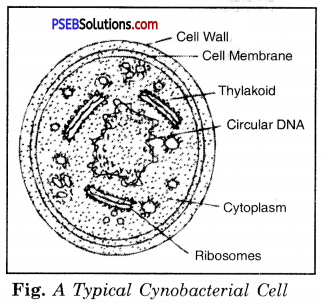
Cyanobacteria.
These are chlorophyll containing autotrophic microscopic bacteria, also called blue green algae. They may be filamentous or colonial in form. Main examples are Oscillatoria, Spirulina, Nostoc, Stigonema.
A typical cyanobacterial cell consists of a four layered cell-wall followed by plasma membrane. The cytoplasm contains gas vacuoles, ribosomes photosynthetic pigments such as chlorophyll a, carotenoids and circular double stranded naked DNA. The reserve food is in the form of cyanophycean starch, liquid globules and cyanophycean protein granules.
Question 24.
What are diatoms ? Sketch a few examples of diatoms.
Answer:
Diatoms.
They are microscopic unicellular algae found in fresh water springs, estuaries and marine water of ocean. They occur mostly as individual cells and some form colonies. Diatoms deposit silicon dioxide in their cell wall. They reproduce asexually as well sexually.
Examples of Diatoms
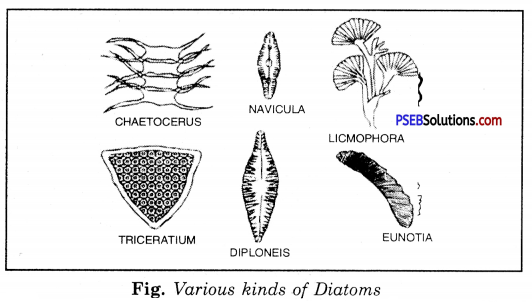
Question 25.
Ajit kneaded 1/2 kg maida along with lukewarm water. He also added some sugar and yeast in it. What will be the effect on kneaded flour after 2 hours ? Give reason for your answer.
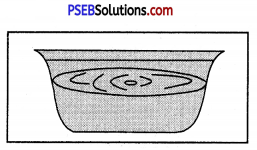
Answer:
The dough begins to rise. The presence of sugar and yeast stimulates rapid growh of the yeast cells. During their reproduction, yeast cells produce carbon dioxide. Bubbles of CO2 fill the dough and make it rise.
![]()
Long Answer Type Questions
Question 1.
Sketch few of the micro-organisms.
Answer:
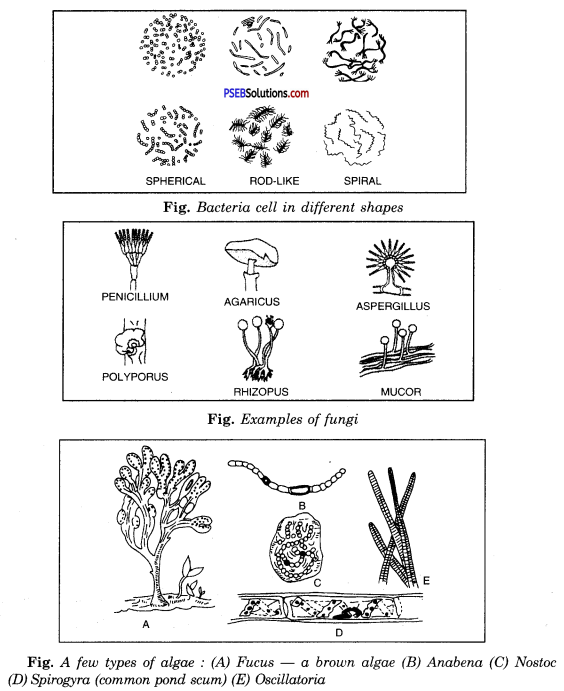
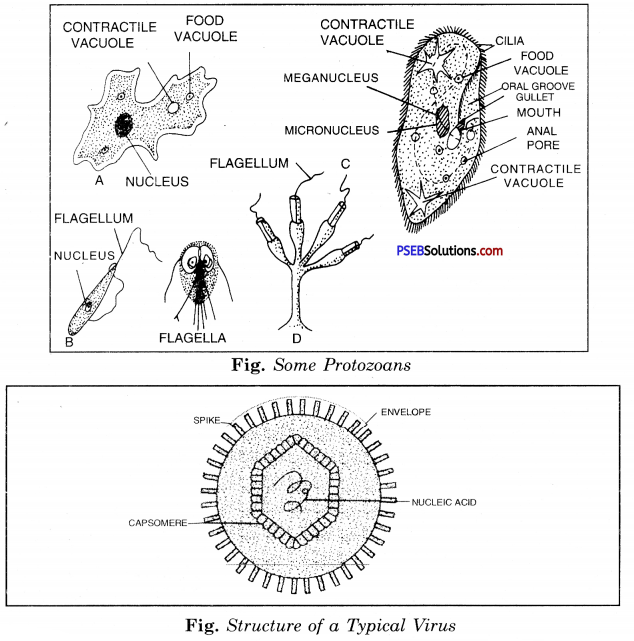
Question 2.
Give in a tabulated form some of the common diseases affecting man and their mode of transmission and methods of prevention.
Answer:
Some Common Human Diseases Caused by Micro-organisms:
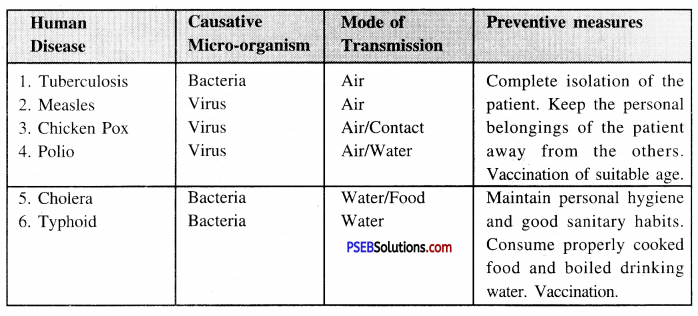
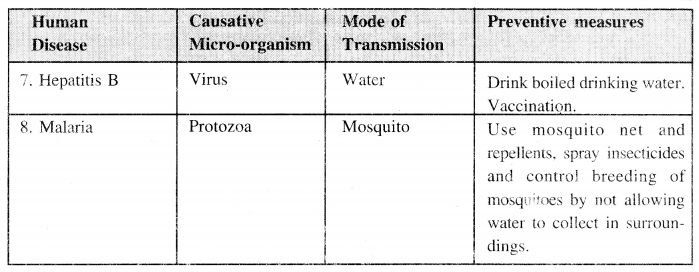
Question 3.
Give some of the common plant diseases caused by micro-organisms.
Answer:
Common Plant Diseases Caused by Micro-organisms
| Plant Diseases | Micro-organism | Mode of Transmission |
| Citrus canker | Bacteria | Air |
| Rust of wheat | Fungi | Insects and seeds |
| Yellow vein mosaic of Ladyfinger | Virus | Insect |
Question 4.
What is meant by food preservation? Explain the different methods of food preservation used for foods.
Answer:
Food Preservation. The processes by which the perishable food materials are treated to prevent their spoilage and retain their nutritive value for long periods
is called food preservation.
The substances used for food preservation are called food preservatives.
Different Methods of Food Preservation:
1. Dehydration and Sun Drying.
The process of removal of water from fruits, vegetables is called dehydration. It reduces the moisture content of food materials and, therefore, prevents the food from spoilage. Drying in the sun is one of the oldest methods of food preservation.
2. Preservation by Salt and Sugar.
Common salt and sugar are good preservatives. These stop the bacterial growth in the food material. Pickles, jam, jelly, ketchup, squash, etc. are preserved by adding salt and sugar.
3. Deep Freezing. It is a direct method for the prevention of bacterial growth. In this method, the food materials are cooled below 0 C. Fruits vegetables, meat, fish, etc. can be easily preserved by this method.
4. Chemical Preservation. Certain chemicals can be used to preserve food. The substances which are added to the food materials to prevent their spoilage are called food preservatives. Benzoic acid, Potassium metabisulphite, etc. can be used. Irradiation, canning, and bottling are also used for the preservation of food.